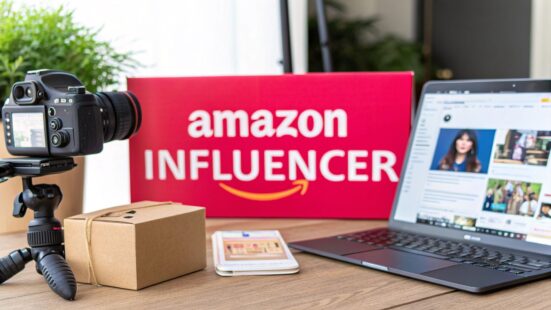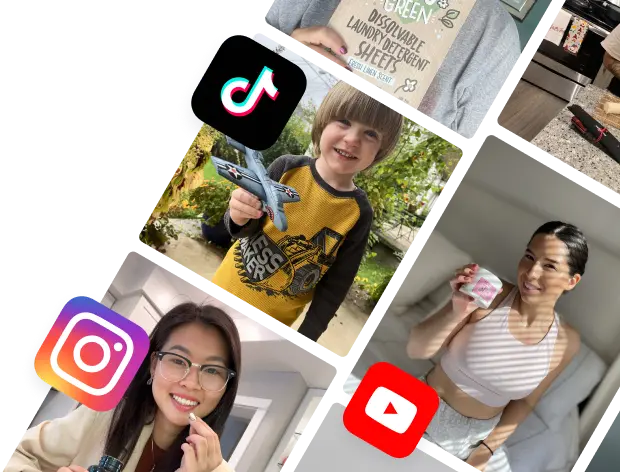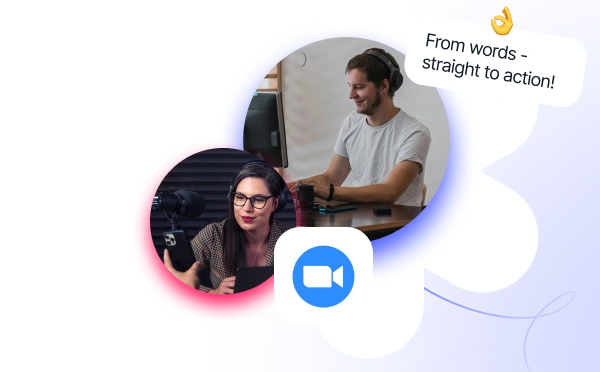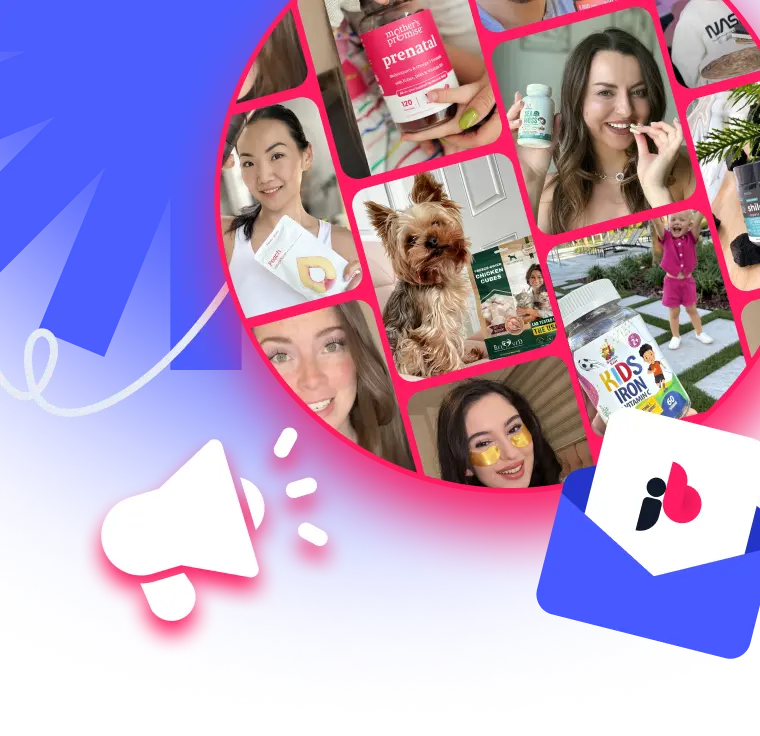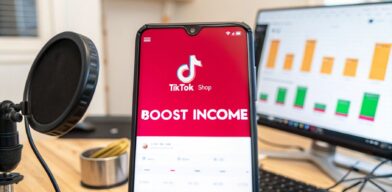 Join the TikTok Shop Affiliate Program & Boost Your Income
Join the TikTok Shop Affiliate Program & Boost Your Income
The Amazon Influencer Program isn't just another affiliate program. It's an invitation-only extension of the well-known Amazon Associates world, but with a major upgrade for social media creators. Instead of just sharing one-off product links, the program lets you create a personalized storefront—a single, branded hub for all your recommendations.
Table of Contents
Unpacking the Amazon Influencer Program
It's easy to get the Amazon Influencer Program mixed up with its older sibling, the Amazon Associates program. They both let you earn commissions from Amazon, but they’re built for very different approaches. The Associates program is the classic model: anyone with a website or blog can sign up, grab individual product links, and share them. You post a link, someone clicks, and you get a cut of the sale. Simple.
The Influencer Program, on the other hand, is designed specifically for creators who already have a solid following on social media. Think of it less like a link-sharing tool and more like being handed the keys to your very own boutique inside Amazon's massive marketplace. You get a custom, shoppable storefront with a clean, memorable URL (like amazon.com/shop/yourname).
Core Concept: The program shifts your role from a simple promoter to a trusted curator. Instead of just slinging links, you’re building a centralized, branded space where your audience can browse and shop all the products you endorse in one convenient spot.
This single distinction changes everything. It elevates the relationship with your audience from a quick, transactional click to a long-term resource they can trust and return to.
Amazon Influencer Program vs. Amazon Associates
To put it in perspective, let's break down the key differences between the two programs side-by-side. While both are monetization tools, how they function and who they're for couldn't be more different.
| Feature | Amazon Influencer Program | Amazon Associates Program |
|---|---|---|
| Primary Tool | A customizable storefront with a unique URL. | Individual product affiliate links. |
| Eligibility | Requires an established following on social media (e.g., YouTube, Instagram, TikTok, Facebook). | Open to almost anyone with a website or blog. |
| User Experience | Followers visit a curated "shop" to see all your recommendations in one place. | Users click a specific link for a single product. |
| Best For | Social media creators, YouTubers, and public figures with an engaged audience. | Bloggers, publishers, and website owners. |
| Monetization | Commissions from storefront sales, On-Site Commissions, Bounties, and more. | Commissions from sales made through specific affiliate links and bounties. |
Seeing it laid out like this makes the choice clearer. If you're building a brand around your personality and taste, the Influencer Program is the natural fit. If your content is more article-based or you're just dipping your toes into affiliate marketing, the Associates program is a great starting point.
The Personal Shopper Analogy
Here’s a good way to think about it: imagine you’re a personal shopper for your audience.
With the standard Associates program, you're basically handing someone a business card for a specific item inside a gigantic department store and hoping they find it. But with the Influencer Program, you’re personally welcoming them into your own curated boutique, where every single item on the shelves is something you’ve hand-picked and genuinely stand behind.
This model makes the entire shopping journey feel seamless and, most importantly, builds trust. Your followers don't have to go on a scavenger hunt for links scattered across dozens of old posts or video descriptions. Instead, they can just pop over to your storefront and see everything you recommend, all neatly organized into helpful categories that you create yourself.
For example, you could set up lists like:
- My Everyday Tech Gear
- Must-Have Skincare Finds
- Kitchen Essentials for Home Cooks
This level of organization makes your recommendations far more accessible and genuinely useful. It strengthens the bond with your audience and, in turn, seriously boosts your earning potential. The Amazon Influencer Program is about much more than just earning a commission; it’s about monetizing your authority and taste in a way that truly serves your followers.
So, you want to join the Amazon Influencer Program? Let's get one thing straight right away.

Many aspiring creators get stuck on the idea that you need hundreds of thousands of followers to even get a look from Amazon. This is probably the biggest myth holding people back. The truth is, Amazon’s approval process is a lot smarter than that. They care way more about the quality of your relationship with your audience than the sheer size of your follower count.
Think about it from Amazon's perspective. They want to partner with people who can actually convince their followers to buy something. A micro-influencer with a small but super-loyal community in a specific niche is often way more powerful than a huge account with a passive, disengaged audience. It’s about real influence, not just big numbers.
That means the metrics Amazon really cares about aren't your follower stats, but your engagement and content quality. They're looking for proof of an active, authentic connection between you and your people.
Follower Count is a Myth. Engagement is Reality.
Let's just clear the air on follower counts. Amazon doesn’t post a magic number you have to hit, and that's because their focus is on how your audience interacts with you. A massive follower number with hardly any likes, comments, or shares is a major red flag. It screams "disengaged."
It’s less about a specific follower target and much more about the quality of your content and your engagement rate. We’ve seen creators get approved with as few as 750 engaged followers, especially on Instagram, where they’re posting detailed, honest product reviews. Engagement is the name of the game. A 5% engagement rate on an account with 500 followers can be worth more to Amazon than a tiny rate on a massive profile. You can see more real-world examples from influencers sharing their experiences.
The bottom line? If you're a creator with a smaller but dedicated following, you are absolutely in the running. Amazon gets that true influence is built on trust, and trust comes from real, consistent interaction.
Key Takeaway: Stop stressing about a follower number. Start focusing on building a community that genuinely listens to you and values what you have to say. That's what makes you a valuable partner for Amazon.
The 3 Pillars of a Strong Application
To give yourself the best shot at getting approved, you need to double down on three key areas. Amazon uses a mix of automated systems and human reviewers, and they’re all looking for clear signs that you have an established, active, and influential presence.
1. A Qualifying Social Media Account
First things first, you have to apply with an active account on one of their approved platforms. Right now, Amazon is accepting applications from creators on:
- YouTube: Perfect for in-depth reviews, tutorials, and unboxing videos.
- Instagram: The go-to for visual content like try-on hauls, Reels, and lifestyle shots.
- TikTok: A powerhouse for short, snappy, and potentially viral product demos.
- Facebook: Works best for creators who already have strong communities and business pages.
Whichever account you choose, it needs to be public and show a solid history of consistent posting. This is the main piece of evidence you're submitting to prove your influence.
2. Consistent, High-Quality Content
Posting once in a blue moon isn't going to convince anyone. Amazon needs to see that you’re consistently creating and sharing content that your audience loves. Your feed should have a clear theme or niche, proving you’re a go-to source for a particular topic.
And "high-quality" doesn't mean you need a Hollywood film crew. It just means your content needs to be:
- Clear and Well-Lit: People need to actually see the product and you!
- Audible: Your sound has to be crisp and easy to understand. No one wants to strain to hear you.
- Authentic: Your reviews should feel real and reflect your genuine thoughts.
3. Demonstrable Audience Engagement
This is the big one. Engagement is the tangible proof that you have influence. It shows Amazon that your audience isn't just scrolling past—they're actively participating.
The key engagement metrics they look for are pretty straightforward:
- Likes and Reactions: The most basic sign of positive feedback.
- Comments and Replies: This shows your content is starting real conversations.
- Shares and Saves: A huge signal that your content is valuable enough for someone to pass along or come back to later.
When you focus on building a real relationship with your followers and making content that truly helps them, you'll naturally develop the exact qualities that make you a perfect candidate for the Amazon Influencer Program.
Joining and Setting Up Your Storefront
So, you've checked the requirements and you're ready to go. The next step is moving from being an applicant to becoming an approved influencer. This part of the journey is pretty exciting—it involves the application itself, a short waiting period, and then the fun part: building your own digital shop.
Think of it as the grand opening of your curated boutique, but right inside Amazon’s massive marketplace. The whole process is designed to be straightforward, but you'll want to follow the steps carefully to make sure everything goes off without a hitch. Let's break down exactly what you need to do to apply and get your storefront ready for business.
Navigating the Application Process
First things first, head over to the Amazon Influencer Program homepage and click "Sign Up." You'll be asked to log into your existing Amazon account or create a new one if you don't have one.
Now for the most important part: connecting the social media account you're banking on for qualification. Whether it's Instagram, YouTube, TikTok, or Facebook, pick the one where your audience is most engaged. This is what Amazon will look at first.
Amazon's system will then automatically scan your account's metrics—things like follower count and engagement rates—to see if you meet their initial bar. For many creators, this initial check is instantaneous. If you hit the numbers, you're in! But that's just the first gate.
This quick visual breaks down the main stages of getting fully approved.

As you can see, it's a simple flow from that first eligibility check to final approval, which usually only takes a few business days once your content is up and running.
Building Your Storefront Foundation
Once you get that initial thumbs-up, you gain access to your influencer dashboard. The very first thing you should do is claim your unique storefront URL. This is your branded digital address on Amazon, so make it memorable and professional. Something like amazon.com/shop/yourname is perfect. A clean URL is way easier for your followers to remember.
With your URL locked in, it's time to start curating. Your storefront is basically an empty canvas just waiting for your personal touch. The best way to organize it is with Idea Lists. These are simply themed collections of products that help your audience find exactly what they're looking for.
Key Insight: The way you organize your storefront directly impacts how useful it is. Well-structured Idea Lists are like the aisles in a physical store—they guide shoppers to what they need and make them want to stick around and browse.
Don't just throw up random lists. Be strategic. Think about what your audience comes to you for.
Curating Your First Product Lists
Your first few Idea Lists really set the tone for your entire storefront. Kick things off with categories that are a perfect match for your content niche.
Here are a few examples to get the wheels turning:
- For a Tech Reviewer: You could create lists like "My YouTube Filming Gear," "Ultimate Home Office Setup," or "Best Budget Gadgets Under $50."
- For a Beauty Creator: Think about organizing products into "My Daily Skincare Routine," "Holy Grail Makeup Finds," or "Hair Tools I Can't Live Without."
- For a Home Cook: Try curating lists such as "Essential Kitchen Appliances," "My Favorite Baking Tools," or "Pantry Staples I Always Restock."
When you create a list, give it a catchy title and a short, genuinely helpful description. Instead of something boring like "Kitchen Stuff," go for something more engaging like "My Top 10 Kitchen Timesavers." This injects your personality and tells your audience why they should check it out.
Adding products is as simple as searching for them on Amazon and clicking "Add to List." This initial setup is your chance to build a trusted, go-to resource that will serve your followers for years to come.
Strategies to Maximize Your Earnings
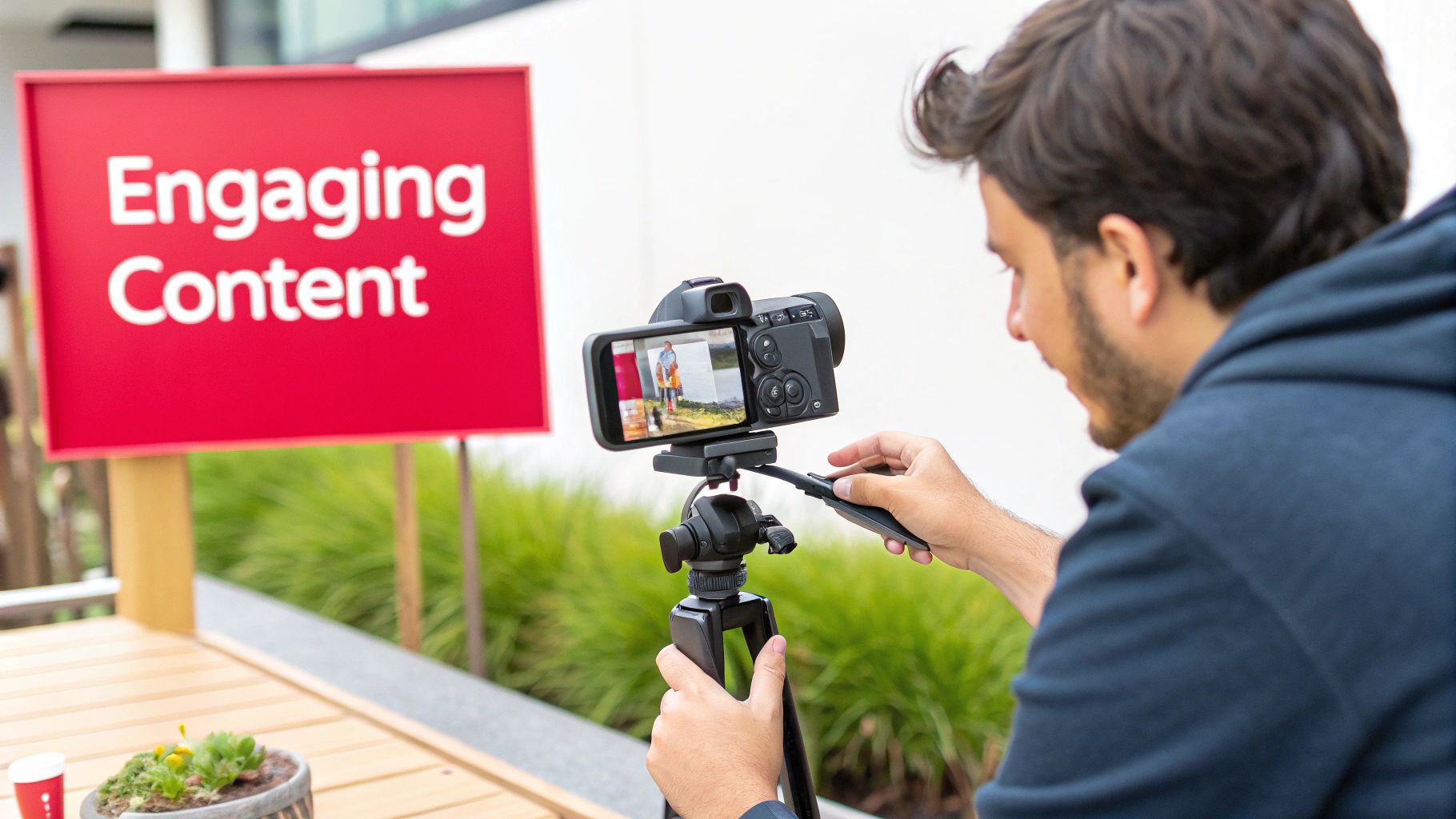
Getting accepted into the Amazon Influencer Program is a huge first step, but it's really just the starting line. The real work—and the real fun—begins when you figure out how to turn your storefront and content into a reliable income stream.
Lots of new influencers get tunnel vision, focusing only on driving people to their main shop page. But the top earners know the secret: the program has several powerful ways to make money, and they all work together. To really crank up your earnings, you need to think of your storefront less like a simple product list and more like the central hub of a powerful money-making machine.
Unlocking On-Site Commissions with Video
If there's one silver bullet for maximizing your income, it's shoppable video. Your storefront is your home base, sure, but your videos are your sales team, out there working for you 24/7 across Amazon's massive marketplace.
When you upload a product review video, it doesn’t just sit on your storefront. Amazon can—and often does—place it directly on the product's detail page. This is an absolute game-changer.
Think about it. A customer is shopping for a new coffee maker. They scroll down the page, see a section called "Videos for this product," and there’s your honest, hands-on review. If they watch your video and click "Add to Cart," you earn a commission. You just made a sale without that person ever visiting your personal storefront. This is called an on-site commission, and it’s where the big money is made.
Key Insight: On-site commissions transform your content into passive income assets. A single great video can keep earning you money for months or even years as thousands of shoppers see it on a popular product page.
Understanding the Commission Structure
Not all sales are created equal. The Amazon Influencer Program is an evolution of the old-school affiliate model, and it uses a tiered commission system where rates change dramatically from one category to another. Payouts can be as low as 1% or climb as high as 20%, so it's critical to know where to focus your creative energy.
For example, you'll see a much better return promoting products in categories like Amazon Games or Luxury Beauty compared to physical video games or groceries. You can check out a full breakdown of the commission rates on Influencer Hero to help plan your content strategy.
Strategically, this means you should prioritize making content for higher-commission products that you already use and genuinely love. A video for a $15 gadget is great, but a solid review for a $500 piece of tech in a high-commission category could multiply your earnings from a single sale.
Leveraging Amazon Bounties
Beyond earning a cut from product sales, Amazon gives you another great way to make money called the Bounty Program. This lets you earn fixed cash payments for getting your followers to sign up for Amazon's various services.
It's basically a referral bonus. Instead of a percentage, you get a flat fee—often $3, $5, or sometimes much more—for driving a specific action.
You can earn bounties for a ton of different Amazon services:
- Amazon Prime: Earn a bounty when someone from your audience signs up for a Prime free trial.
- Audible: Get a fixed payment for every person who joins Audible through your link.
- Kindle Unlimited: Drive new subscriptions and get a set commission for each one.
- Amazon Business: Earn a pretty hefty bounty for referring new business accounts.
You can promote these bounties right on your storefront, in your video descriptions, or across your social media. Sprinkling these promotions into your content is a fantastic way to diversify your income. You can make money even when your followers aren't in a shopping mood.
A single mention of an Audible trial in a video about your favorite books can open up a whole new revenue stream. This balanced approach—combining on-site video commissions, smart product choices, and bounties—is the blueprint for winning with the Amazon Influencer Program.
Promoting Your Amazon Storefront Effectively
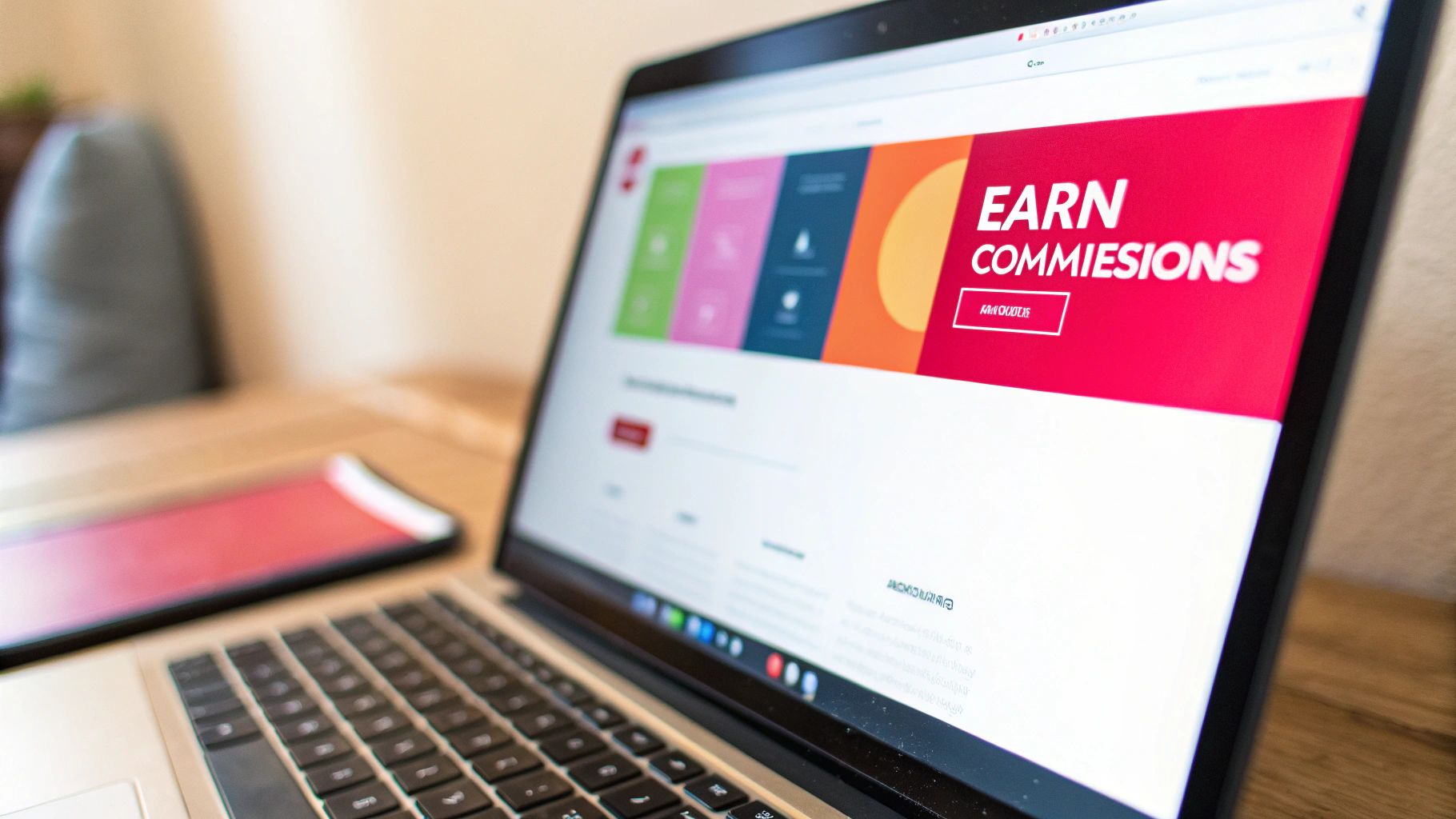
Alright, so you've built out your Amazon Storefront and your first product lists are live. It feels like the hard part is over, right? Not quite. In reality, a beautiful storefront with no visitors is like a stunning retail shop hidden down a back alley—it won’t generate sales on its own.
This is where the real work begins. Effective, consistent promotion is what separates a passive hobby from a profitable business within the Amazon Influencer Program.
Think of your storefront as your central hub. Your social media channels are the network of roads that bring people there. Your job is to make that journey as easy and appealing as possible. This means treating your storefront link not as an afterthought, but as a critical piece of your online identity.
The goal isn't to become a walking advertisement. It's about weaving your storefront into the content your audience already knows and loves. When you get it right, a promotion feels like a helpful recommendation from a trusted friend, not a pushy sales pitch.
Make Your Storefront Impossible to Miss
First things first: make your storefront link painfully easy to find. If your followers have to hunt for it, they'll give up. Fast. Your storefront URL should be treated like prime real estate across all your social media profiles.
You need to place your unique amazon.com/shop/yourname link in these can't-miss spots:
- Instagram & TikTok Bios: This is the most valuable digital real estate you own on these platforms. Make it your "link in bio" so it's always just one click away.
- YouTube Channel Banners & Descriptions: Add your storefront link directly to your channel's main banner and, just as importantly, drop it in the description of every single video you post.
- Facebook Page "About" Section: List it clearly on your business page where people naturally go to get more information about you.
This simple setup ensures that no matter how someone discovers you, they have an immediate path to browse your curated collections.
Key Takeaway: Don't make your followers work to find your storefront. Placing your link in your social media bios is the single most effective way to drive consistent, passive traffic from your existing audience.
Create Content That Points to Your Store
Just having the link available is step one. Step two is actively creating content that gives people a reason to click it. This doesn’t mean every post should scream, "BUY MY STUFF!" The real art is in weaving your recommendations naturally into your existing content.
Consider making content specifically designed to show off your storefront's value. You could film a quick video tour of your shop, walking followers through how it's organized and highlighting a few of your favorite lists. This kind of "meta" content teaches your audience how to use the resource you've built for them, making them more likely to come back.
Another killer tactic is using platform-specific features to your advantage. For example, Instagram's "Link Sticker" in Stories is perfect for pointing directly to a specific Idea List. Talking about your morning routine? Slap on a sticker that links straight to your "Morning Essentials" list. It’s direct, helpful, and contextual.
Leverage Timely and Themed Product Lists
One of the most powerful promotional strategies is building and promoting Idea Lists that tap into seasonal trends, holidays, and events. People are already looking for this stuff, so you're simply meeting them where their interest is highest.
Think about the calendar year and what your audience is focused on:
- Winter: Holiday Gift Guides ("Gifts for Him," "Tech Gifts Under $100"), Cozy Home Essentials
- Spring: Spring Cleaning Must-Haves, Outdoor & Gardening Gear
- Summer: Summer Travel Essentials, Beach Day Favorites, Grilling Accessories
- Fall: Back-to-School Supplies, Fall Fashion Finds, Halloween Decor
When you create these timely lists, promote them heavily in the weeks leading up to the event. A well-curated holiday gift guide shared in November can become a go-to resource for your followers, driving serious traffic and sales. For more perspective on the broader world of creator partnerships, you can look into how the top influencer marketing agencies operate.
By aligning your content with what's already on your audience's mind, your storefront becomes an indispensable tool. This strategic approach is what turns a passive link into an active and thriving revenue stream.
Here is the rewritten section, crafted to sound completely human-written and natural, following the provided style guide and examples.
The Future of Creator-Led Commerce
Let's be honest, the way we shop online has completely changed. We're not just clicking on banner ads or taking a brand's word for it anymore. Instead, we're turning to the creators we actually follow and trust to get real advice on what’s worth our money. This massive shift is what we call creator-led commerce, and the Amazon Influencer Program is sitting right in the middle of it all.
This isn't some flash-in-the-pan trend. It’s a fundamental change in how we, as consumers, behave. We're tired of glossy, perfect product photos and want to see how things work in the real world, used by real people. When a YouTuber you’ve followed for years recommends a new microphone or a specific brand of coffee, it feels less like an advertisement and more like a solid tip from a friend. Amazon saw this coming and built an entire ecosystem around it, giving creators their own storefronts to turn those authentic recommendations into a ridiculously easy shopping experience.
The Rise of Authentic Partnerships
The days of paying for a single, one-off sponsored post are quickly fading. The smart money in creator marketing is now on building sustainable, long-term relationships—a model that an Amazon storefront naturally encourages. When you build out a curated storefront, you’re not just chasing a single viral hit; you're establishing yourself as a trusted authority in your niche. You become the go-to resource your audience can count on, month after month.
This move toward lasting collaborations isn't just a hunch; it's happening across the entire industry. The data backs it up, showing that nearly 47% of brands now prefer building long-term partnerships over quick, short-term campaigns. If you want to dive deeper into this and other market trends, check out this comprehensive influencer marketing report. It all points to one thing: the trust you build with your audience is your most valuable asset, and your Amazon storefront is the platform that helps it grow.
Emerging Trends Shaping the Future
As powerful as this all is right now, creator-led commerce is still evolving. There are a few key trends on the horizon that are going to make programs like Amazon's even more central to how we shop.
- The Surge of Live Shopping: Think of it as QVC, but hosted by your favorite creator in their own home. That's the magic of Amazon Live. It lets you demonstrate products in real-time, answer questions from your audience on the spot, and basically shrink the path from discovery to purchase down to zero. With over 52% of marketers already getting into live streaming, this interactive format is set to explode.
- AI-Powered Curation: Get ready for AI to become your new best friend in optimizing your storefront. Soon, we'll see AI tools that can analyze your audience and suggest high-commission products that are already trending with your specific followers. It could even help you spot content gaps in your niche, allowing you to make smarter, data-driven decisions on what to feature.
- Hyper-Niche Influence: As the creator world gets more crowded, the real power will shift to the specialists. Creators who absolutely own a tiny niche—whether it's restoring vintage film cameras or finding the best sustainable kitchen gadgets—will become incredibly valuable. Amazon's program is built for this, letting you curate highly specific collections that serve a dedicated and passionate audience.
Final Takeaway: Joining the Amazon Influencer Program is about more than just earning a commission check today. It's about planting your flag in the future of retail. This is a future that’s driven by authentic creators and woven directly into the content we already love. You’re not just setting up a shop; you’re building a business at the very forefront of where commerce is headed.
Have Questions? We’ve Got Answers
Stepping into a new platform like the Amazon Influencer Program always brings up a few questions. It's totally normal, and honestly, it’s smart to get the details sorted out before you dive in. We’ve rounded up some of the most common queries we hear to clear things up and get you moving.
Let's start with the big one: money. How do you actually get paid? Amazon sends out payments about 60 days after the month closes. So, for commissions you rack up in July, you can expect to see that cash around the end of September. That little buffer gives Amazon time to process any customer returns, which would then be backed out of your earnings.
Payments and Tracking
What if a follower from the UK or Canada buys something from your storefront? Do you still get a commission? The answer is a solid yes, but there's a small catch. You’ll need to sign up for the Associates Program in each specific country to collect those international earnings.
And how can you tell which of your review videos are actually making an impact?
- Your Reporting Dashboard: Amazon gives you a pretty slick analytics dashboard. You can track clicks, how many items have shipped, and, of course, your total earnings.
- Reading the Tea Leaves: While you can’t see direct view counts on your videos, you can see which products are selling. This is your best clue for figuring out which reviews are turning your viewers into buyers.
A Quick Pro-Tip: Don't get lost in the weeds analyzing every single video's stats. Look for the bigger picture. If products from your "Home Office Gadgets" idea list are consistently selling, that's your cue to double down and create more content in that niche.
Another question that pops up a lot is about watch time. Does a shopper really have to watch your video for 30 seconds? While Amazon hasn't carved this into stone publicly, 30 seconds is the widely accepted industry benchmark. If your video is shorter than that, the viewer needs to watch the whole thing for you to get credit for the sale.
Ready to connect with a massive network of verified Amazon influencers and other creators? JoinBrands offers an all-in-one platform to find the perfect partners for your brand, manage campaigns effortlessly, and generate high-quality user-generated content that drives sales. Start your campaign today at JoinBrands.
